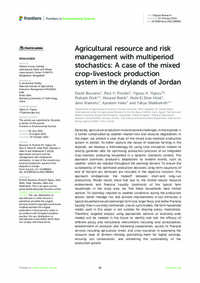Agricultural resource and risk management with multiperiod stochastics: A case of the mixed crop-livestock production system in the drylands of Jordan

Authors:
Generally, agricultural production involves several challenges. In the drylands, it is further complicated by weather-related risks and resource degradation. In this paper, we present a case study of the mixed crop-livestock production system in Jordan. To better capture the nature of response farming in the drylands, we develop a methodology for using crop simulation models to directly generate data for optimizing production practices of an integrated crop-livestock producing household in a dynamic stochastic context. The approach optimizes producer’s adaptations to random events, such as weather, which are realized throughout the planning horizon. To ensure the sustainability of the optimized production decisions, long-term valuations of end of horizon soil attributes are included in the objective function. This approach endogenizes the tradeoff between short-and long-run productivity. Model results show that due to the limited natural resource endowments and financial liquidity constraints of the typical farm households in the study area, we find these households have limited options. To optimally respond to weather conditions during the production season, better manage risk, and achieve improvements in soil attributes, a typical household would need larger farm size, larger flock, and better financial liquidity than it currently commands. Like all such models, the farm household model used in this paper is not suitable for drawing policy implications. Therefore, targeted analysis using appropriate sectoral or economy-wide models will be needed in the future to identify and test the efficacy of different policy and institutional interventions including land consolidation, establishment of producer and marketing cooperatives, access to financial services including agricultural credit, and crop insurance in expanding the resource base of farmers—thereby positioning them for higher earnings, ensuring soil conservation, and enhancing the sustainability of the production system.
